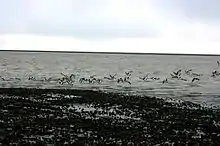Holtsós
Holtsós, sometimes anglicised as Holtsos, is a tidal lagoon[1][2] south of Eyjafjallajökull in south Iceland. It is fed by the Holtsá river and separated from the Atlantic Ocean by a narrow strip of sand. It is approximately 4 kilometres (2.5 mi) long by 2 kilometres (1.2 mi) wide and approximately 2 metres (6.6 ft) deep at its deepest point.
| Holtsós | |
|---|---|
 Holtsós | |
| Location | Iceland |
| Coordinates | 63.547635°N 19.743233°W |
| Type | lagoon |
| Max. length | 4 kilometres (2.5 mi) |
| Max. width | 2 kilometres (1.2 mi) |
| Max. depth | 2 metres (6.6 ft) |

Ecology
The lagoon has a sedimented bottom and no appreciable salt gradient. Species found there include Gammarus zaddachi and Gammarus duebeni.[3] Eurasian oystercatchers frequent it.[4] Above Holtsós is a deep freshwater pool called Hellisvatn after the cave that overlooks it, Steinahellir, which was the location of the district assembly for Eyjafjöll from 1818 to 1905.[5] Hellisvatn does not freeze and therefore attracts many birds in winter when other sources of water are frozen over.
Like other shallow lagoons, Holtsós is prone to overflow its banks when the river feeding it runs high, and it is often necessary to keep the opening to the ocean open against sedimentation to prevent flooding of the adjacent land.[6]
History and literature
Mediaeval names for the lagoon were Holtárós, Holtavatn or Holtavatnsós.[7][8][9] In the 12th century, ships sometimes used it as a harbour.[10] Its frequent flooding is mentioned in one of the Old Norse accounts of Bishop Þorlák, Jarteinabók Þorláks saga byskups önnur.[11][12] The farm called Holt, immediately to the west, was an important centre in the Middle Ages, and Holtsós is probably also identical with the Arnarbælisóss of Njáls saga.[9][13]
Holtsós also occurs in one of the Icelandic folktales recorded by Jón Árnason. A fisherman has a dream foretelling that he will undergo a test at sea off Holtsós. He lays his boat up and believes he has avoided the danger when it is destroyed on land by a storm, but then crewing for another man, he is the only casualty when another storm blows up and the ship is wrecked off Holtsós.[14][15]
References
- Arctic Pilot Volume 2, Iceland, Jan Mayen, Bjornoya, Svalbard, and the east coast of Greenland together with the adjacent seas, NP 11, Taunton: United Kingdom, Hydrographer of the Navy, 1996, ISBN 9780707710112, p. 76.
- Sailing Directions (enroute) for Greenland and Iceland, Publication 181, 7th ed., Bethesda, Maryland: United States, National Imagery and Mapping Agency, 2002, ISBN 9780160674648, p. 183.
- Kustbiotoper i Norden: hotade och representativa biotoper, TemaNord 2001:536, Copenhagen: Nordic Council of Ministers, 2001, ISBN 9789289306263, p. 302 (in Swedish)
- Fuglar, Eyjafjöll.is (in Icelandic), retrieved 29 April 2013.
- Steinahellir cave, Eyjafjöll.is, retrieved 29 April 2013.
- Neues Jahrbuch für Geologie und Paläontologie: Monatshefte (1961) 468 (in German)
- Torfhildur Þorsteinsdóttir Hólm, Elding: söguleg skáldsaga frá 10. öld, Reykjavík: Sigfúss Eymundsson, 1889, OCLC 4538717, p. 678 (in Icelandic)
- Brennu-Njáls Saga, ed. Einar Ólafur Sveinsson, Íslenzk fornrit 12, Reykjavík: Hið Íslenzka fornritafélag, 1971, OCLC 27952270, p. 56 (in Icelandic)
- Helgi Þorláksson, Gamlar götur og goðavald: um fornar leiðir og völd Oddaverja í Rangárþingi, Ritsafn Sagnfræðistofnunar 25, Reykjavík: Sagnfræðistofnun Háskóla Íslands, 1989, OCLC 30514148, p. 76 note 4 (in Icelandic)
- Helgi Þorláksson, pp. 71, 76.
- Ásdís Egilsdóttir, ed., Biskupa sögur, Volume 2, Íslenzk fornrit 16, Reykjavík: Hið Íslenzka fornritafélag, 2002, ISBN 9789979893165, p. 103 (in Icelandic)
- Fálkinn, 20 February 1959, p. 7 (in Icelandic)
- Íslendínga sögur volume 4, Njála (Njáls saga) Volume 2, Det Kongelige nordiske oldskrift-selskab, Copenhagen: Gyldendal, 1889, OCLC 460535010, p. 821 (in Danish)
- Georgia Dunham Kelchner, Dreams in Old Norse Literature and Their Affinities in Folklore, Cambridge: Cambridge University, 1935, OCLC 594447, p. 38.
- "Reikningsskapurinn fyrir Holtsós", Jón Árnason, Íslenzkar Þjóðsögur og Æfintýri, Volume 1, Leipzig: Hinrichs, 1862, OCLC 492517190, p. 416 (in Icelandic)